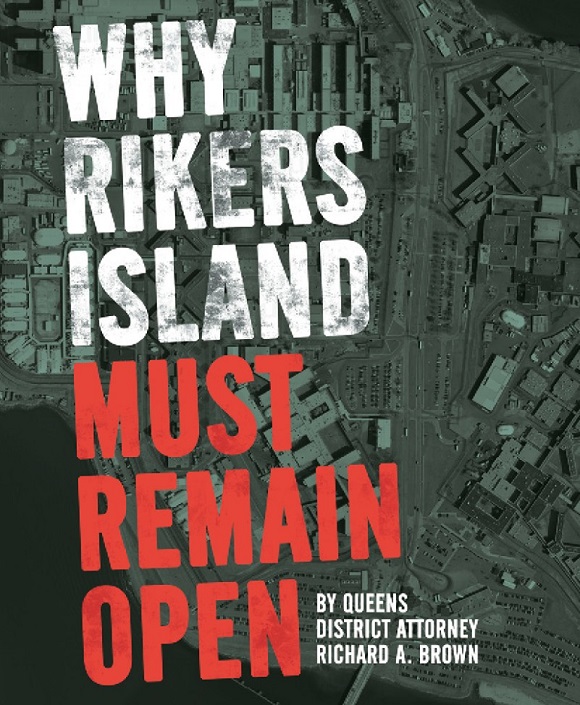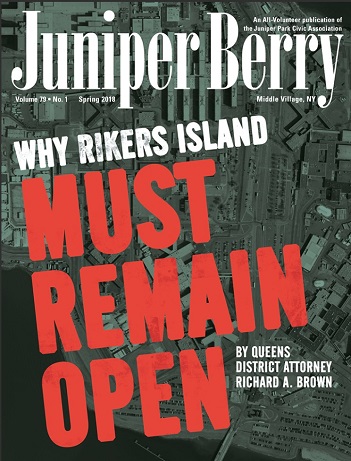I start from the proposition that it is unrealistic to close down Rikers Island when there exists no viable place to put those who are incarcerated there. It would cost the City billions of dollars in demolition and construction costs and wreak havoc upon the City’s neighborhoods as new jails are built in residential areas. Witness, for example, the attempt to convert a hotel into a homeless shelter in Maspeth, which the City has had to partly abandon due to widespread, vehement protests on the part of the community. That scene would be replayed all over the City if jails are proposed for residential neighborhoods.
Beyond that, such local jails would, in my opinion, eventually suffer the fate of the Queens House of Detention, abandoned in 2002, and not even fit today for use as a correction officer training facility. It is now essentially a movie set. It could be put to far better use as District Attorney office space, which would save the City over three million dollars a year in the rent that it now pays for our office space in a privately-owned building and as I testified before the City Council in 2016, I am willing to pay for a substantial portion of its conversion out of our Federal asset forfeiture funds.
Rather than close Rikers altogether, it makes far more sense to modernize it than to waste a fortune destroying it and building new jail facilities. While it would require an initial one-time investment to renovate the existing facilities, it is an investment well-spent in the long run. The plan to build a new facility on Rikers, begun under Mayor Bloomberg and recently continued under Mayor de Blasio, is a good step forward. Renovation plans should also include a mental health facility, a re-entry center, better medical facilities, an upgraded visitors’ center and improved transportation to and from the island to make it easier for inmates to be brought to and from court and to receive visits from their families.
Painting Rikers Island as a “penal colony” and simply getting rid of it will not solve the larger problems that the criminal justice system faces in this City. What will help is a concerted effort to ensure that only the people who belong in Rikers Island are put there. As you know, that effort has already borne fruit in the reduction of its population. In 1990, the average daily inmate population was 21,000; in 2007, 14,000; and now it stands at about 10,000. That figure includes not just detainees awaiting trial and sentenced misdemeanants, but also sentenced felons who are awaiting transfer to state prisons.
And let me dispel the myth that Rikers detainees are comprised entirely of first-time misdemeanor offenders who are detained solely because they cannot make bail. In Queens County, we consistently find that about 94% of misdemeanor defendants and 79% of felony defendants are released on bail or on their own recognizance. In a typical week, fewer than 6% of the misdemeanor defendants have bail set instead of being released on their own recognizance. And nearly all of those have prior arrests, convictions, or bench warrants, or have other criminal cases pending, increasing their incentive to flee and thus making bail appropriate.
For example, as of October 13th, 2017, there were only 47 Queens misdemeanor defendants who were at Rikers solely because they could not make bail — in other words, defendants who did not have parole or probation holds, who had not been remanded without bail or had bail set in another case, and who were not sentenced state prisoners. Of those 47:
• All but one had at least one other open criminal case, and the majority had multiple open cases.
• All but eight had prior convictions — one defendant had some 96 prior convictions.
• All but sixteen had a history of failing to appear in court.
In other words, the overwhelming majority of Queens defendants never even see the inside of Rikers Island and those who are sent there should be there. That is in part due to my office’s careful review of cases pre-arraignment so that we can make appropriate bail recommendations. It is also due in part to existing bail review and habeas corpus procedures, by which defendants can apply to the court for reductions in bail.
Nonetheless, some of the inequities of the current bail system should be corrected so that even fewer defendants wind up at Rikers. Under current New York law, while a judge may consider a defendant’s prior criminal record, and in domestic violence cases whether the defendant has used or possessed a firearm, those considerations are relevant only in the context of “the kind and degree of control or restriction that is necessary to secure his court attendance” — in other words, whether the defendant is likely to flee — not whether he or she is likely to be a danger to others. That restriction has resulted in the unfair effect of keeping a poor, non-violent defendant in jail while a wealthier, violent one could go free. Consideration of future dangerousness, coupled with existing bail review procedures, would help eliminate this inequity, improve public safety and ensure that only defendants who really need to be detained are held at Rikers.
Moreover, low-level and non-violent offenders can be — and are being — kept out of Rikers through alternative sentencing programs. For example, in partnership with the court system, my office has had great success with programs such as Supervised Release, Second Chance, the Queens Youth Part, the Queens Court Academy and the Youth Diversion Program. There are also a host of special courts designed to provide services and treatment, rather than incarceration, to offenders with mental health and substance abuse issues.
These are just some of the programs available to divert these kinds of offenders away from incarceration.
Another innovative and successful way of reducing the Rikers population has been the myriad youth crime prevention programs which my office coordinates, such as the Star Track School Anti-Violence Program, a high school mock trial/moot court program, a Boy Scouts Legal Explorers post, a Student Advisory Council, tours of the courts, a Summer Youth Employment Program and Operation Summer Fun, which provides younger children with recreational activities. These programs help keep youngsters out of the criminal justice system altogether.
Finally, reforming or eliminating certain correctional practices is an important step toward ensuring that those who do go to Rikers are treated appropriately. In 2016, the Mayor and former Commissioner Ponte announced that no inmate under 21 would be subject to punitive segregation and instead would receive therapy to address behavioral issues. And the Bronx District Attorney — who has jurisdiction over Rikers — has established a new Rikers Island Prosecution Bureau specifically designed to address contraband smuggling and gang violence, and her Public Integrity Bureau has successfully prosecuted a number of corrupt correction officers at Rikers. And reforms instituted by the Department of Correction, including improved anti-violence policies and training, resulted in a 50% drop in violent incidents in the first six months of 2017 as compared to the same period in 2016.
In short, there is no need to throw the baby out with the bath water. Closing down Rikers Island — if it can be done at all — would waste taxpayer dollars and blight neighborhoods — it simply makes no sense when it can be improved through continued, determined efforts to keep out the people who don’t belong there and improve the conditions for those who do.




